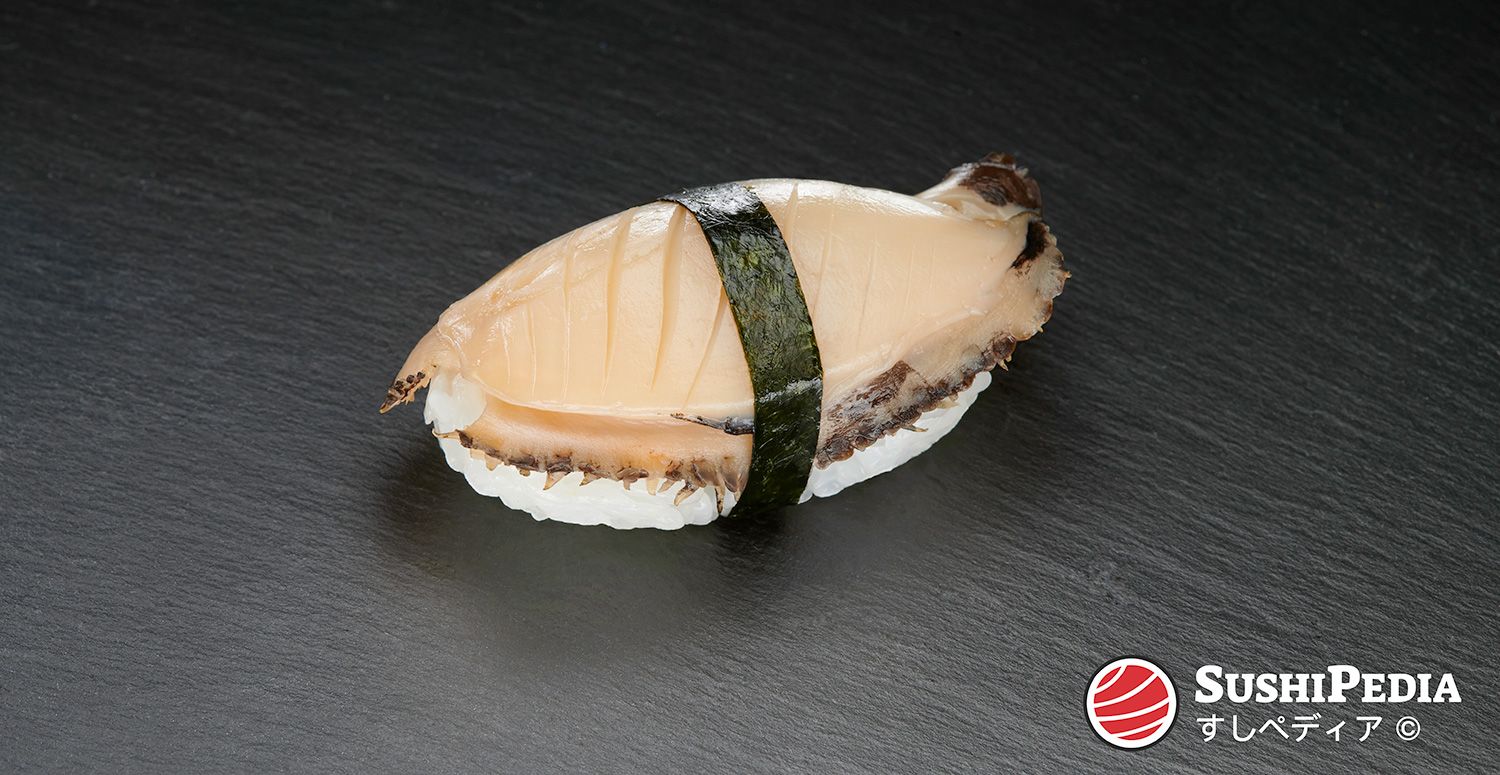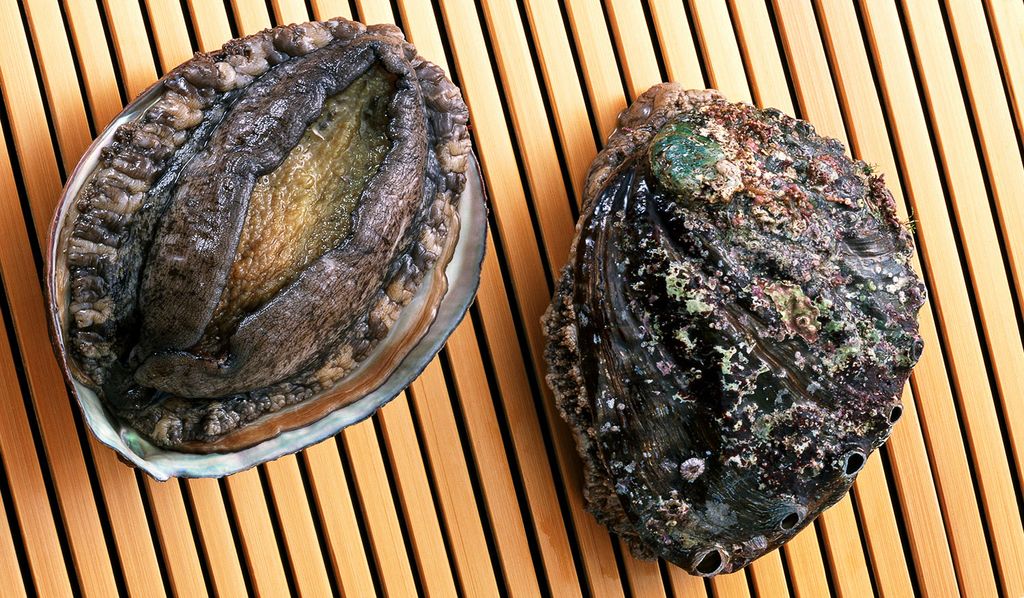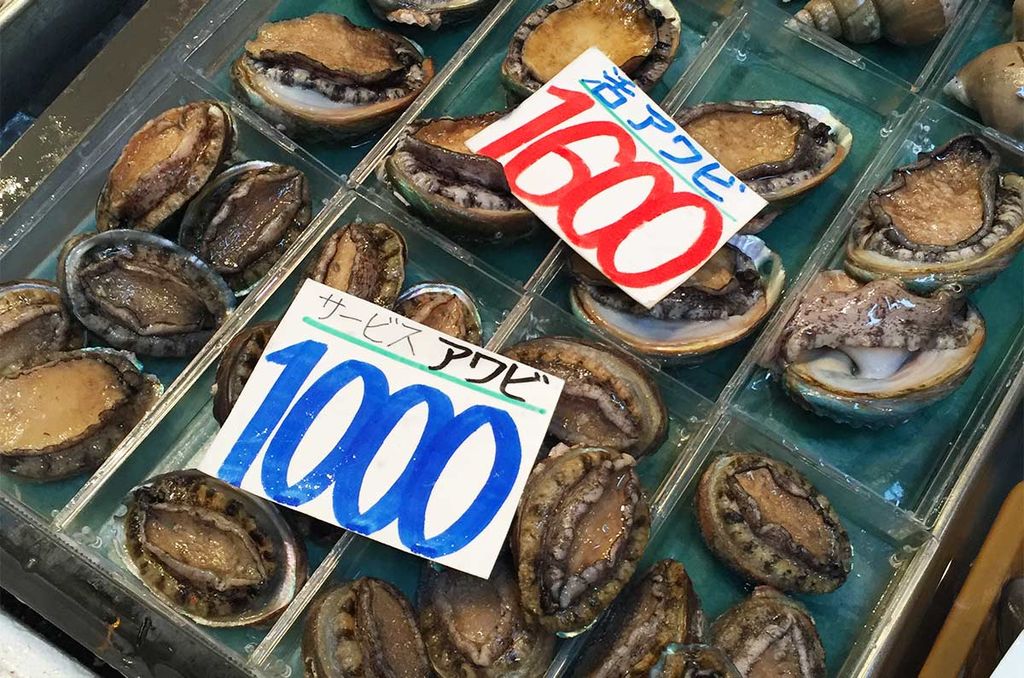Awabi Sushi
A Comprehensive Overview of Abalone in Japanese Sushi Cuisine
アワビすし 、 鮑寿司 
What is Awabi?
Abalone are called awabi in Japan, they are a genus of large marine snails, which resemble an auricle in their shape. They are considered a sought-after delicacy, especially in Asia, and are especially in demand in Japan as an ingredient for the preparation of sashimi and sushi. High-quality specimens are counted among the most expensive sushi ingredients.
Awabi for Sushi or Sashimi

Unknown author. Awabi Abalone for Sushi - Insights into Japanese Delicacies
In Japan, the muscle meat of the awabi is highly valued for the preparation of various dishes. When preparing Sushi or as Sashimi, the freshness of the awabi plays a central role. For this reason, they are usually killed shortly before preparation. Eaten is unfortunately the muscle foot, which is cut into slices. The consistency is crispy and firm, but not tough.
In addition to the raw, freshly prepared iki awabi (活きアワビ), the cooked variant mushi awabi (蒸しアワビ) is also highly appreciated as nimonodane sushi. The awabi is salted before cooking and then heated in a mixture of sake and water, for example. Of very large awabi, such as the madaka-awabi, the cooked liver is considered a special delicacy. Moreover, it is said in Japan that the taste of the male awabi, is superior to those of the female specimens.
Awabi in Japan
Besides the preparation of sushi or sashimi, there are different dishes in which awabi are steamed, salted, boiled, chopped or cooked in soy sauce. In some regions of Japan, awabi liver is considered a special delicacy. Probably one of the most unusual methods of preparation is a soup made from salted abalone, mixed with yams (awabi no tororo-jiru, 鮑のとろろ汁).
In Japan, it is customary to give awabi as a gift to someone to whom one wishes a long life. The custom is derived from the fact that awabi meat is very elastic and this metaphor should be applied to the to the life of the receiver of this gift.[1]
In the old Japanese folk belief (shintō) awabi serves as a symbol of female fertility. Because the appearance of the awabi resembles female genitalia and labia, it is used by the Japanese as a circumlocution of the vulva.[2][3]
Closely related to abalone is the Japanese tradition of ama (海人), the Japanese term for apnea mussel divers. These are usually women who also dive for the highly coveted abalone, among other seafood.
Types of Awabi

Unknown author. Market Overview and Pricing of Awabi Abalone in Japan. All rights reserved ©
Abalones reach a size of up to 20 cm. The shape differs according to the species. Abalones prefer rocky reefs at a depth of about 20 m. The predominant diet consists of brown algae. It is almost impossible to distinguish female and male Abalones from the outside. On the basis of the gonads, however, a distinction can be made. The sex can be distinguished by opening the abalone and comparing the color of the gonads. The gonads of male abalone are whitish and those of females are green.
Tokobushi and Awabi: Different Types of Abalone in Japanese Cuisine
In Japan, tokobushi (トコブシ) and awabi are umbrella terms for different types of abalone, all belonging to the genus Haliotis. Although they belong to the same genus biologically, they differ in size, taste, usage, and market value.
The term awabi refers to larger types of abalone, such as kuro awabi and ezo awabi. These abalones are known for their thick, tender flesh and delicate flavor. They are often served raw as sashimi or sushi and are considered a delicacy. Tokobushi, on the other hand, are smaller types of abalone with less flesh and a flatter shell that usually has more holes. Their flesh is firmer and is more typically used in cooked dishes. Nevertheless, they can also be used for preparing sushi or sashimi, though they are far less flavorful. Due to their firmer flesh, they are typically cooked when used in sushi. In such cases, they are referred to as ni-gai 煮貝, which literally means “cooked shellfish.” Additionally, the term ni-awabi 煮鮑 is also used. Whether a tokobushi can be considered an awabi varies depending on the perspective.
Awabi is more expensive due to its size and delicate flavor, and is regarded as a particularly high-quality delicacy. The market for these abalones is highly regulated to prevent overfishing, as they have become rare in the wild. Tokobushi, on the other hand, is more affordable and readily available. These smaller abalones are often offered as a cheaper alternative to the more expensive awabi, especially in preserved or frozen forms.
Kuro Awabi
Among connoisseurs, kuro awabi, literally translated “black abalone”, is considered the tastiest awabi-species and is accordingly expensive. It is also said that kuro awabi is best suited for sashimi because its firm flesh smells pleasant and has a full flavor. The best season is considered to be late spring to summer.
Kuro awabi is also called o-gai, which is understood as “male awabi or male mussel”.
Ezo Awabi
The taste of ezo awabi is similar to that of kuro awabi and is also traded as a high-quality ingredient. Since it is a subspecies of kuro awabi, the flavor, texture, and aroma are not significantly different. Wild specimens are most palatable in winter, while products from aquaculture are available and tasty all year round.
Megai Awabi
Megai-awabi (メガイアワビ) belongs to the larger species and is preferably used for the preparation of cooked dishes. The meat is noticeably tenderer and less crispy, but for preparation as sushi or sashimi, the taste is inferior to that of kuro- and ezo-awabi. The most delicious are megai-awabi during the summer.
Megai-awabi is also called “female mussel” (mengai, メンガイ, 雌貝) in Japanese.
Economy of Awabi
![Diagram of global production of abalone (Haliotis spp., Concholepas concholepas) from 1950 to 2018, broken down by wild catch and aquaculture (marine and brackish water). [Source: FAO. 2020. Fishery and Aquaculture Statistics. FishStatJ. fao.org]](/_astro/awabi-abalone-global-production.qlVGost2_1v06hs.jpeg)
SushiPedia. Abalone (awabi) production (1950-2018). All rights reserved ©
Since the second half of the 19th century, overfishing has led to a sharp decline in stocks. Particularly in Asia, as well as along the west coast of the United States and in Australia, some species are commercially bred in aquacultures. The shells of the abalones are valued as decorative objects and as a source of nacre (mother-of-pearl) for jewelry and inlays, among other things.
According to the Food and Agriculture Organization, the largest share of the world market in 2018 comes mainly from China (83%), followed by South Korea (10%) and Australia (2%) .[4]
Video about Awabi Sushi
External video embedded from: youTube.com. Credit SUSI TOMOKI. Master's Genuine Nigiri-Zushi Series 6 Preparation of Abalone for Sushi Ingredient.
Species of Awabi
The following species are regarded as authentic awabi. Either historically, according to the area of distribution or according to the common practice in today's gastronomy:
0
0
0
In the following, those species are listed that can be considered as substitutes for authentic species with regard to awabi. This can be based either on their genetic relationship or on their similarity in taste and appearance. The selection is subjective and is not strictly based on Japanese conventions, but also takes into account the practices in the respective areas where the Japanese dishes are prepared. This flexible approach allows for adaptation to local availability and preferences while preserving the core flavor and texture traditionally associated with awabi. This list is not exhaustive due to the possible diversity of species worldwide.
Sources and Further Reading
- [1]T. Volker. The Animal in Far Eastern Art: And Especially in the Art of the Japanese Netzsuke, with References to Chinese Origins, Traditions, Legends, and Art. Koninklijke Brill, Leiden. 1975
- [2]Friedrich S. Krauss. Anthropophyteia. Deutsche Verlagaktiengesellschaft, Leipzig. 1909
- [3]Anne Kasschau, Susumu Eguchi. Using Japanese Slang: This Japanese Phrasebook, Dictionary and Language Guide Gives You Everything You Need To Speak Like a Native!. Tuttle Publishing, Boston. 2015
- [4]Fisheries and Aquaculture Department. Fishery and Aquaculture Statistics. Global production by production source 1950-2019 (FishstatJ). Food and Agriculture Organization of the United Nations (FAO), Rome. 2021. Source retrieved 5/12/2021
- Asako Kishi. Sushi: A Light and Right Diet. Japan Publications, Tokyo. 1986
- Casson Trenor. Sustainable Sushi: A Guide to Saving the Oceans One Bite at a Time. North Atlantic Books, Berkeley. 2009
- Hobday, A. J.; Tegner. M. J.. Status review of white abalone (Haliotis sorenseni) throughout its range in California and Mexico. NOAA Technical Memorandum NMFS. . 2000
- National Marine Fisheries Service. White Abalone | NOAA Fisheries. Last updated by NOAA Fisheries on 01/17/2024. Source retrieved 6/6/2024
- 中原 一歩. 『「㐂寿司」のマダカは幻の鮑。 (Madaka of "Kizushi" is a phantom abalone.)』. Dancyu, President Co., Ltd.. 2019. Source retrieved 3/20/2021
- 小泉 武夫. 『奇食珍食 (Strange Food and Rare Food)』. Chūōkōron Shinsha, Tokyo (中央公論新社, 東京都). 1994
- IUCN Red List of Threatened Species. Version 2023-1
Image Credits
- Unknown author. Market Overview and Pricing of Awabi Abalone in Japan. All rights reserved ©
- Unknown author. Awabi Abalone for Sushi - Insights into Japanese Delicacies
- SushiPedia. Awabi Sushi Nigiri. All rights reserved ©
- SushiPedia. Abalone (awabi) production (1950-2018). All rights reserved ©